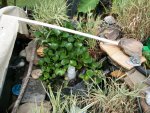Just a quick rundown on how a pond is supposed to work. Bacteria are everywhere, even in fresh water when you first fill the pond. Once ammonia is introduced, whether by fish waste products, rotting leaves or pond plants, or by simply dumping a cup of it into the water, the nitrosomonas bacteria will rapidly multiply and "eat" the ammonia. As a waste product of this process, nitrite is produced. A second set of bacteria, nitrobacter, then multiplies, feeding on the nitrite, while the nitrosomonas die back. (Unless more ammonia is added to the water.) The waste product of the nitrobacter bacteria is nitrate, which is far less deadly to fish than ammonia or nitrite. However, there are no bacteria to break down the nitrate, so it builds up in the water UNLESS it is diluted (water changes) or used by plants as fertilizer. And "plants" includes algae, which can quickly turn your water into a green soup, as many ponders have discovered!
If you haven't fallen asleep yet, I'll get into the second part of this boring story. The beneficial bacteria live EVERYWHERE in your pond, either free-floating in the water or attached to the liner, rocks, decorations, and yes, even the plants. If you use a UV sterilizer, the free-floating BB can be killed off by going through it, just as algae can, but in practical terms this has very little effect on the pond. There are enough BB attached on every wet surface to keep the cycle going. The roots of your water hyacinths have a massive surface area, and so provide places for the BB to cling, but your plants have a far more important role to play... they use up much of the nitrate, keeping levels below the danger point for your fish. Regular testing of the water is the ONLY thing that will tell you if this cycle is working as it should. If you consistently find ammonia in the water, your fish load (bio-load) is too high, and a bio-filter should be installed in the system.
I've often heard people complain that their fish keep dieing, but their water is 'crystal-clear'. Well, guess what; so is pure ammonia! Even if you are convinced your water is perfect, only testing will tell the whole story. Hope this rather lengthy tirade has helped you (or other beginners) to understand a little more about the nitrogen cycle.
John





